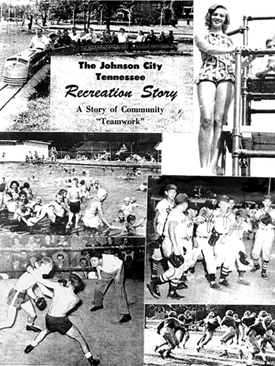A 17-page pamphlet from 1954 titled, “The Johnson City Tennessee Recreation Story – ‘A Story of Community Teamwork,’” owned by Harrison “Frosty” Stout, was shared with me through Larry Ledford and Alan Bridwell.

The city’s recreation story can be traced to a City Basketball League game in 1947 at an unidentified location matching Leon Ferenbach and Gloria Rayon. Ferenbach superintendent, J.J. Jilton commented to someone, “This is a great game. It’s too bad it has to be played in this cracker box.” The location was not specified.
That causal statement was taken as a challenge to Recreation Director Howard Johnson who replied to Jilton, “Are you willing to help build a better place?” The same query was put to Bill Jenkins, coach and manager of the Gloria Rayon team, and other participants of the league. Several men met on January 12, 1947 for the purpose of forming a club for people interested in building a community recreation center for the city.
Charter members were J.M. Carter (president), Robert F. Smith (vice-president), Howard Johnson (secretary-treasurer), Ted Jilton, Roy Feathers, Lawrence Owens, William Whittimore, Kent Neufer, J.J. Jilton, Eric Herrin, Mrs. and Mrs. Jimmy Smyth, Edna Frances, J.R. Jilton, Sells Blevins, Sam Cooper, William Jenkins, Bill Billings, Kathleen Goodin, Mr. and Mrs. Eddie Cowell, Nelson Burris, Roy Well, Joe Walker, Ted Burton and Nathan Thorp.
The group approved a 3-phase campaign to raise funds for the construction of a new sports facility: selling memberships in a recreation club; sponsoring athletic events, carnivals and other money-raising activities; and soliciting financial contributions.
On January 28, 1947, the organizers met with the Park and Recreation Board (C. Howard McCorkle, chairman; P.W. Alexander; W.J. “Dub” Smith; Mrs. H.C. Black; and M.U. Snodderly) and received a “thumbs up” for the club.
Phase 1 began by netting $5,190.92 from 919 memberships, several sizable donations and numerous contributions resulting in part from the promotional efforts of Jimmy Smyth of the Johnson City Press-Chronicle and Eddie Cowell, host of WJHL radio’s “Sports Parade.”
Phase 2 was launched with a dance by noted bandleader Tony Pastor and his group on Friday, March 28, 1947. During that gathering, the Junior Chamber of Commerce raffled off an automobile. Unfortunately, attendance was sparse due to a record snowfall and cold temperatures. The club also held a “Buy-A-Brick for One Dollar” campaign and awarded an automobile at a 4-Star Motorcycle Race at Memorial Stadium on July 5, 1947. This and several other fundraisers increased the fund total to $6,336.47.
When the endowment reached $15,000, the club decided to break ground for the new building. The plan, drawn up by Bob Woods, called for a 160’ by 80’ building on Legion Street. The Park and Recreation Board maintenance crew, headed by Dewey Stout and supervised by Howard Jenkins, commenced construction work on July 8, 1948.
Footings were poured for the walls and afterward Southern Welding Company erected structural steel. General Shale Corporation graciously donated 10,000 cinderblocks and several suppliers of materials offered substantial discounts. The walls went up block-by-block and work proceeded on installing the roof until funds were exhausted, bringing a momentary pause to the project.
To the rescue came the Junior Service Auxiliary (Mrs. William G. Preas, general chairperson), donating funds from their September 28-29, 1949 “First Annual Johnson City Horse Show.” This effort added $2,663.49 into the fund allowing work to resume.
Phase 3 endeavors to solicit financial contributions to the building were not as promising, the main drawback being that three other significant money-raising efforts were occurring simultaneously in the city.
Fortunately, two organizations came forward – the National Federation of Employees (through the efforts of Vic Larmer and Charles Roller) and the Model Maniacs (Charles Hawkins and Caroline Muse). These two groups, along with former contributors of the Recreation Club, backed a highly successful Halloween Festival on Oct. 29-31, 1949, generating $991. About this time, City Commission approved a $10,000 loan for the recreation project.
With renewed funding, final work on the building proceeded with the pouring of a four-inch concrete floor, laying four by four creosote boards as sub-flooring and installing 16,000 square feet of hardwood flooring attached with 1000 pounds of nails. After completion, Allen Harris, Jr., a prominent local flooring businessman, commented, “I think this is one of the most beautiful floors I have ever seen.”
The long-awaited Recreation Building opened to the public on January 5, 1950, appropriately featuring a basketball game by the City Basketball League. The town no longer had to play the game in a “cracker box.” In early 1952, the balconies to the building were completed bringing total floor space to 24,000 square feet. Early1953 saw a modern entrance to the building along with a skate room, the installation of 2,000 seats, glass backboards and steel steps.
Over time, the city’s other playgrounds were improved and collectively began offering a variety of programs (sandbox, tennis, swimming, square dancing, roller-skating and baseball), each under the supervision of two or more trained leaders.
Special weeks were featured that focused on an activity such as “Tournament Week” (competition in paddle tennis, aerial tennis, horseshoes, checkers, croquet and others), “Fair Week” (displays of outstanding arts and crafts and hobby creations), “Sportsmanship Week” (special recognition to those who display good sportsmanship in games and contests), “’Citizenship Week” (special recognition of those who made the park more attractive and interesting) and others.
Various events were three-legged races, sack races, dashes, broad jumps, softball throw, basketball goal shooting contests and bicycle derbies were also held. Spring and summer brought softball and baseball leagues (Pee Wee, Midgets, Little League, Pony, Junior and Twilight Softball Leagues at the various ball fields. Fall and winter activities featured boxing and bodybuilding programs for boys and men.
The recreation brochure concluded by revealing “A Typical Day on a city Park & Recreation Playground” that opened at 9 a.m. and closed at 10 p.m. The city had something of which to be proud.
